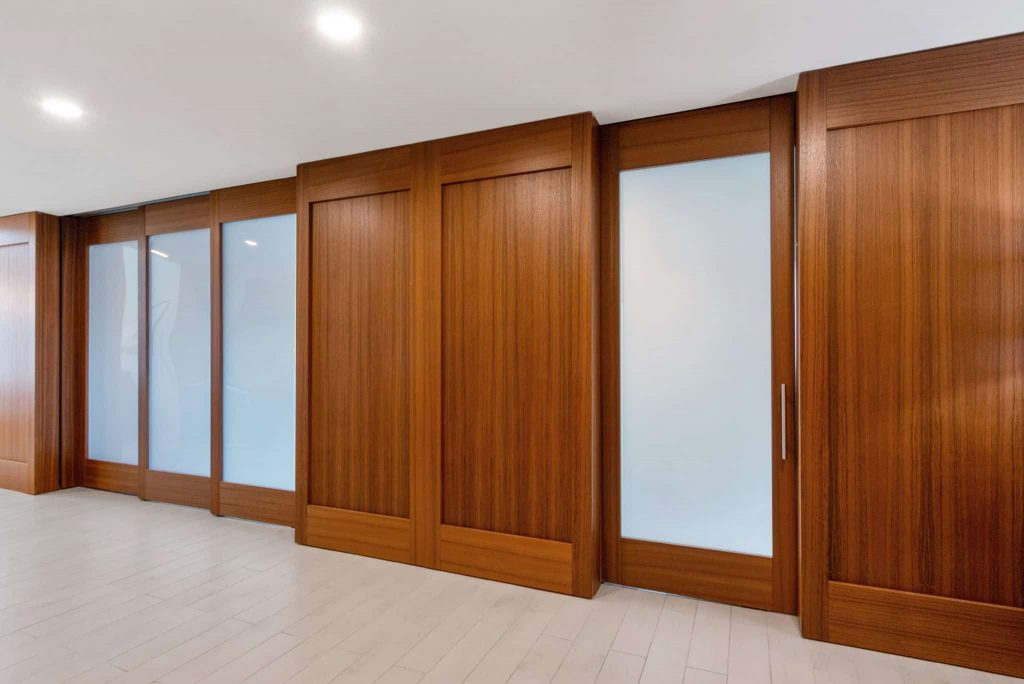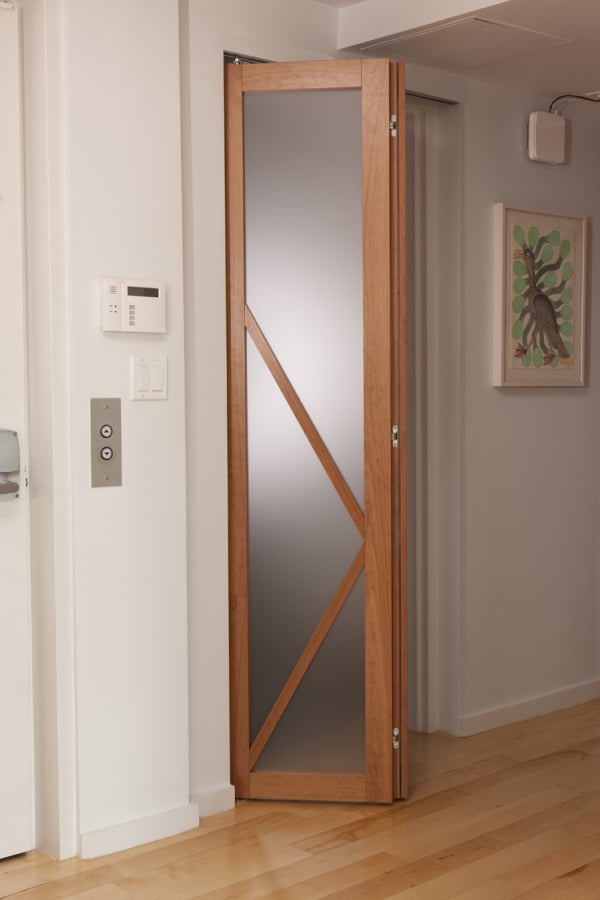Specifying a glass door for your next project? If so, you’re in good company. Countless interior designers and architects choose glass for its enduring, sophisticated look and versatility. But with so many different products, design treatments, and customization options, there is more to choosing a glass door than meets the eye.
The Raydoor team is passionate about connecting designers with the doors, operable walls, and room-dividing solutions that will work best for the particularities of their projects. Our guide below will help you find the perfect fit for your mood board.
The Most Popular Glass Door Options on the Market
We’ve organized our list into three main categories — sliding doors, folding doors, and swinging doors — describing how that particular type of door operates and its most appropriate use cases.
At Raydoor, we offer many of our solutions in both acrylic and glass glazings. To that effect, we’ve included several examples of our previous acrylic projects below, as they leave the same bold design impression as comparable glass solutions on the market. With that in mind, let’s take a closer look.
Sliding
Imagine a glass door, and a sliding system is probably the first that comes to mind. Sliding glass doors may be relatively simple and widely available, but the potential applications are nearly endless — from tight-cornered closet spaces to wide-spanning commercial environments. Customizations can also take this widely available category to an even higher level of design excellence.
1. Single

Single sliding glass doors are a top contender for minimalist designs or rooms where square footage is limited. Our single-panel systems drift smoothly on a ceiling-mounted track to reveal or close off an area. Closet doors, kitchen pantries, bedrooms, and other close quarters can all benefit from sliding doors when a traditional swinging system just won’t do the trick.All of our single-sliding solutions are available in both glass and acrylic glazings. Read our guide on the differences to learn which material is right for your project.
2. Barn-Style

Although typically configured as a single- or double-sliding door, barn doors have a distinct natural and warm look and feel that makes them a sought-after feature in home and commercial environments with a rustic style. Glass paneled barn doors create an interesting blend of traditional and contemporary elements that is sure to make a statement.
3. Bypassing

A bypassing door is a sliding system where two or more panels can move in front of or behind each other to create any number of configurations between fully open and fully closed. This option is ideal for medium-sized openings or spaces requiring a truly flexible approach to room division.
4. Pocket

True to their name, pocket doors neatly stow away into a “pocket” within the wall, all but vanishing from view while open. Some designers and architects hold less than favorable opinions of pocket systems, as they can be clunky or bulky, and they do require a large cavity within the wall incorrectly. Ill-equipped builders are another common contributor to pocket system malfunctions, as the issues can stem from poor construction as often as they do from poor hardware.
Our pocket solutions feature a lightweight construction that, fortunately, mitigates these issues. Shedding excess weight allows for a smoother and quieter experience while in use.
5. Stacking
Stacking glass door systems feature multiple panels that slide in and out of place and stack together when fully opened. The result is a more architectural look that allows end users to reconfigure their space however they see fit.
Our highly customizable approach to creating stacking systems for our clients gives them full control over accessibility and other design requirements. In many respects, Raydoor stacking systems more closely resemble a dividing wall when closed than a door. That’s because they use one track in the opening (regardless of the number of panels used) and because the panels butt together (which means there is no overlapping). Pair them with an egress door, stack them parallel or perpendicular, and add as many panels as your opening requires.
Presently, we only offer stacking solutions in our highly durable acrylic glazing, which presents the same luxurious impression as glass but with a lighter weight, fewer panel size limitations, and easier shipping, installation, and maintenance.
Folding
Folding doors rely on a set of hinges or joints to collapse panels or sections back in on themselves, as opposed to swinging, pivoting, or sliding open. They are well-regarded for their cost-effective, space-saving construction, and incorporating glass inserts is an easy way to elevate their design, make full use of natural light, and opt for a scratch-resistant, sound-isolating division system.
6. Bifold

Bifold doors technically describe two-panel systems that fold into one another, but the term is also used for folding doors made with more than two attached panels. Bifold doors are occasionally referred to as concertina doors.
Swinging
Ease of access, simple installation, and visual appeal are just a few of the advantages that swinging doors bring to the table.
Most swinging doors rely on a side hinge to open inward or outward, which often means installing a door jam that adds visual clutter to the division space. Our swinging solutions are jambless, meaning that most of the essential hardware is hidden away for a clean look and simple installation.
Combined with glass panels, our sliding doors deliver sophisticated, one-of-a-kind appearance.
7. Single

Single swinging doors may provide a straightforward division solution, but they can also be artfully executed when paired with creative frames, patterns, and insert glazings. As with all of our solutions, we aim to create room divisions that are fully flexible within the spaces they inhabit. To that effect, our swinging doors do not require a header, which allows for a continuous ceiling from one area to the next.
8. Double

Double swinging doors provide all the same benefits as a single-paneled system but with an even more awe-inspiring presentation.
9. French-Style

By definition, french-style doors are a pair of swinging doors that are typically lighter weight and feature glass or other transparent panels, making them an often-used application when natural light is a priority. This classic look has found its way into home offices, bedrooms, hotel rooms, and other spaces seeking a sophisticated charm.
10. Pivot
Unlike standard hinged doors, pivot doors are mounted on a central pivot point, allowing the door to swing open with a smooth, effortless motion. This unique mechanism creates a visually striking effect, as the door can appear to “float” within the frame, adding a sense of elegance and intrigue, especially for high-end projects. The free-flowing nature of pivot doors makes them a perfect complement for designs where spatial flow and visual appeal are top of mind.
Don’t Forget: Custom Doors Are an Option, Too

Despite the many kinds of glass doors available, it’s often the case that stock solutions can only go so far in helping you realize your design vision. Perhaps the size of the opening requires a unique division solution, or maybe you’re simply on the hunt for the perfect finish.
We believe that artful room division often requires a bespoke approach, which is why we offer a wide range of custom and design options — and our glass products are no different. While using glass does create certain restrictions (the heavier nature of the material, for example, introduces panel size restrictions that are necessary to maintain a lightweight product), its durability and strength do present new opportunities in our designs. For example, the additional rigidity means we can offer low-profile frames that offer even less visual interruption.
Frequently Asked Questions
1. What Are the Types of Glass Material Commonly Used in Glass Doors?
Tempered glass is the glass of choice for most door and window applications due to its safety benefits. Unlike non-tempered glass, which shatters into sharp pieces, tempered glass breaks into rounded shards that are less likely to cause injuries. Tempered glass is also stronger than regular, untreated glass, which makes it a better candidate for handling everyday bumps.
2. What Are the Benefits of Glass Doors?
Glass doors provide a modern, timeless aesthetic that accommodates many different design styles. Compared to acrylic, glass has a higher scratch resistance, improved sound insulation, and nonflammable properties.
3. What Are Some Popular Alternatives to Glass Doors?
From a material perspective, wood, acrylic, and polycarbonate are three in-demand alternatives to glass glazing. Acrylic and polycarbonate are highly durable, lightweight, and have a highly competitive price point, while wood veneers and other solid panel inserts give maximum privacy and a natural quality.
Redefine Your Spaces With RAYDOOR Glass™
Since 2000, our patented TWINFRAME® panels have created one-of-a-kind looks in residential, commercial, and hospitality interiors. Now, we’re offering a fresh take on the bold design, lightweight durability, and optical clarity that has made our TWINFRAME® construction a household name.
Featuring higher scratch resistance, sound insulation, and nonflammable properties, our RAYDOOR Glass™ solution is made with tempered glass inserts for specifications where glass is preferred over acrylic.
See the difference glass can make in our catalog.








